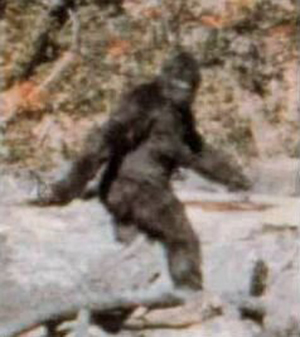
LONDON (AP) — European researchers are planning to use new techniques to analyze DNA that could help crack the mystery of whether Bigfoot exists.
In a project announced this week, Oxford University and Lausanne Museum of Zoology scientists appealed to museums, scientists and Yeti aficionados to share hair samples thought to be from the mythical ape-like creature.
New genetic tests will be done on just a few strands of hair and should be completed within weeks. Even if the sample is judged to come from an unknown species, scientists should be able to tell how closely it is related to other species, including apes or humans.
Bryan Sykes of Oxford University said the group had already received many offers of samples to test, including blood, hair, and items supposedly chewed by Bigfoot. Sykes and colleagues plan to sift through the samples for the next few months before deciding which specimens to test. They will then publish their results in a peer-reviewed journal.
Other experts agreed recent advances made in DNA testing could theoretically solve the Bigfoot question.
“If the Yeti is real and somebody has found bits of their hair, you should be able to tell from the DNA in the hair if this is actually a Yeti,” said Mark Thomas, a professor of evolutionary genetics at University College London. He is not connected to the Bigfoot project.
But Thomas was unsure how likely it was anyone might have actual Yeti hairs. Some scientists theorize Yetis are either a distinct hominid species, or a mix between homo sapiens and Neanderthals or other species. There is already evidence of interbreeding between homo sapiens and Neanderthals.
“If Yetis have survived for the last 30,000 years, they have probably had a pretty miserable existence and are a small population vulnerable to extinction,” Thomas said. “It’s not as insane an idea as many might think, but the chances are pretty small.”
Sykes said he has always been intrigued by stories of Yeti sightings, but would rely on science rather than such tales to prove if the stories are credible. “It’s not really possible to fabricate DNA evidence,” he said.
He acknowledged that the chances of proving the existence of a new Yeti species are low, but said that the study was still worthwhile. “If we don’t look, we’ll never find out,” he said.
Bigfoot is a legendary giant, hairy, ape-like beast that is variously known as Sasquatch, the Abominable Snowman, Yeti and other names. It supposedly lives in heavily forested or snowy mountains. Although most scientists don’t believe in the beast’s existence, decades of eyewitness reports, suggestive photos and stories have kept the legend alive.
The most famous of all alleged Bigfoot/Sasquatch sightings was captured in a film shot by Roger Patterson and Robert Gimlin on Oct. 20, 1967 in Bluff Creek, California. Many years later, an acquaintance of Patterson’s named Bob Heironimus, came forward to make the claim that he had worn an ape costume for the making of the film.
David Frayer, a professor of biological anthropology at Kansas University, told The Associated Press in an email that “No serious scientist (would) treat Yeti as a worthy research project.”
He said previous tests on supposed Yeti hairs have already been done — “and they turned out to be from a bison.”
# # #
Copyright 2012 Associated Press. All rights reserved. This material may not be published, broadcast, rewritten, or redistributed. Auction Central News International contributed to this report.

